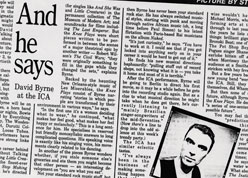ORIGINAL
PRESS CLIPPINGS

Maximum Art in Minimalist Plays
The program contains Wilson's storyboard scenario and drawings for the 13 segments, as an aid to the audience in following the images. You can read into them a variety of interpretations. I tend to see religious and political connotations: of personal and societal transformations, life out of death, spiritual and social evolution.
The program begins with a T-shaped tree (a cross?), made up of a grid of squares, and a copper-headed puppet of a man (in Eden? the Crucifixion?) in the air, being moved by several Bunraku-style manipulators. The man climbs down, but is chased back up by a lion (a dancer here: a weaker image). The man settles in the tree to read a book.
In the next section, a calamity occurs. Lighting strikes (the expulsion from the Garden? nuclear destruction?), and the tree slowly falls. The once solid structure atomizes, and the pieces scatter. Only a tiny square, projected on a slide, remains; that square will be seen many times during the evening. The actual square-grid "branches" are used to build a cabin.
In Knee Play 3, the people build an ark out of the cabin logs. Next, a large bird made of sticks — again, manipulated from below — takes the man from the boat and flies away. The boat is beached and people write graffiti on it, using colored flashlights; a slide projects colored patterns.
In Knee Plays 6 and 7, the boat is fired upon by a cannon and breaks up. The hull sinks and the cabin floats on, to land on the shores of Japan. There, Admiral Perry entertains a fisherman with a puppet show that suggests violence directed against the weaker Japanese figure.
In Knee Play 8, on projected film of water, the hull (on a projected slide) sinks. In Knee Play 9 — which seems to be the segment most dissociated from the others — a Japanese basket-seller picks up a piece of rice while his collection of wares dances.
In the final Knee Plays, 10-13, people pull the boat hull from the water during "the Civil War." There are army tents; next, in a jungle, people begin to read the writing on the hull, and a book is ingeniously assembled from the square-grid boat. This book is then taken from a library shelf by a man wearing a Buddha-like mask. He reads. A tree grows from the book.